Navratri 2025: Dates and Schedule
In 2025, Navratri will be observed from Sunday, 30 March to Monday, 7 April. During this sacred period, devotees across India fast, perform rituals, and participate in cultural festivities, seeking divine blessings for prosperity, wisdom, and protection. The main rituals of Navratri involve installing idols or images of the Goddess in homes and temples, engaging in prayers, and concluding the festival with idol immersion (Visarjan) on Vijayadashami.| Important Occasion | Goddess Worshipped | Date | Day |
| Pratipada, Day 1 | Maa Shailputri - Goddess of Purity & Strength | 30 March 2025 | Sunday |
| Dwitiya, Day 2 | Maa Brahmacharini - Goddess of Devotion & Knowledge | 31 March 2025 | Monday |
| Tritiya, Day 3 | Maa Chandraghanta - Goddess of Peace & Serenity | 1 April 2025 | Tuesday |
| Chaturthi, Day 4 | Maa Kushmanda - Goddess of Energy & Creativity | 2 April 2025 | Wednesday |
| Panchami, Day 5 | Maa Skandamata - Goddess of Motherhood & Protection | 3 April 2025 | Thursday |
| Shashthi, Day 6 | Maa Katyayani - Goddess of Courage & Bravery | 4 April 2025 | Friday |
| Saptami, Day 7 | Maa Kalaratri - Goddess of Destruction of Evil | 5 April 2025 | Saturday |
| Ashtami, Day 8 | Maa Mahagauri - Goddess of Wisdom & Purity | 6 April 2025 | Sunday |
| Navami, Day 9 | Maa Siddhidatri - Goddess of Spiritual Power & Fulfillment | 7 April 2025 | Monday |
On the final day, Navami (9th day), devotees perform Kanya Pujan, where young girls (symbolizing the goddess) are worshipped and offered sweets and gifts.
Navratri Celebrations Across India
Western India: Gujarat and Maharashtra – Garba, Dandiya, and Devotion
In Gujarat, Navratri is a grand community event where people gather in large open spaces to perform Garba and Dandiya Raas. Devotees dress in traditional attire, and the nights come alive with music, rhythmic claps, and energetic dance moves. Cities like Ahmedabad, Vadodara, and Surat are the best places to witness these celebrations.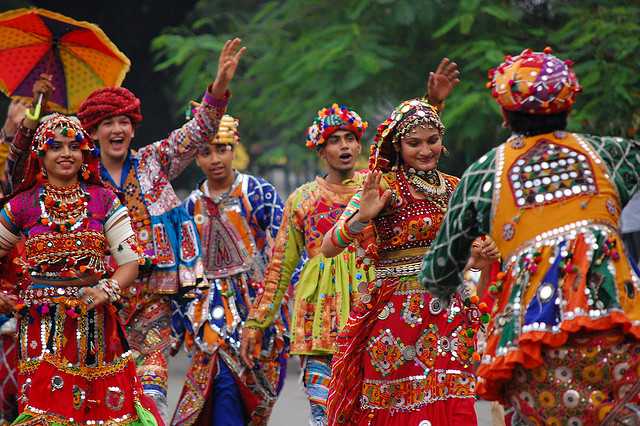
Eastern India: West Bengal – The Grand Durga Puja
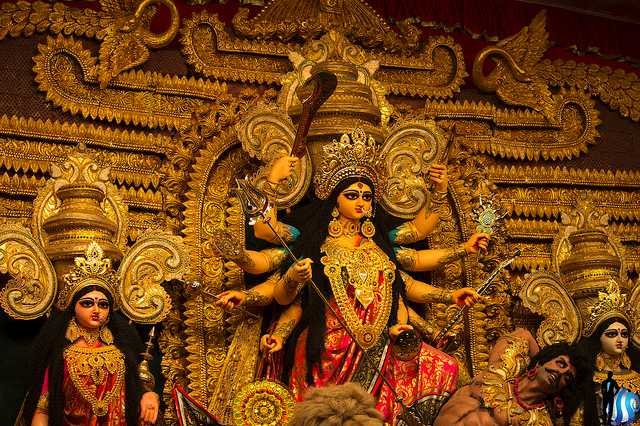
- Elaborate Durga idols installed in community pandals
- Traditional Dhunuchi dance and Dhak drumming
- Sindoor Khela, where married women smear each other with vermillion
- Immersion of idols on the final day with grand processions
South India: Mysore Dasara and Bommaikolu Display
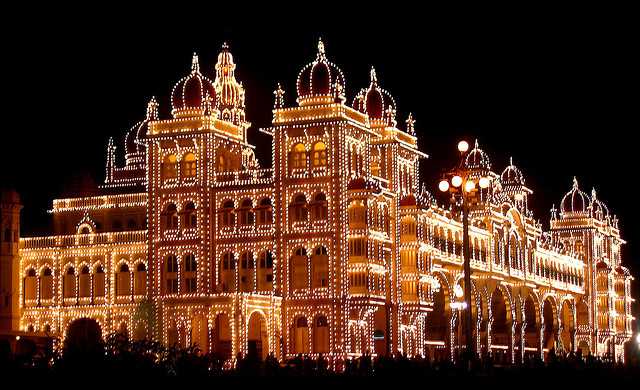
- A grand procession of elephants and horses
- A traditional sword-worship ceremony by the royal family
- Music, dance, and cultural performances
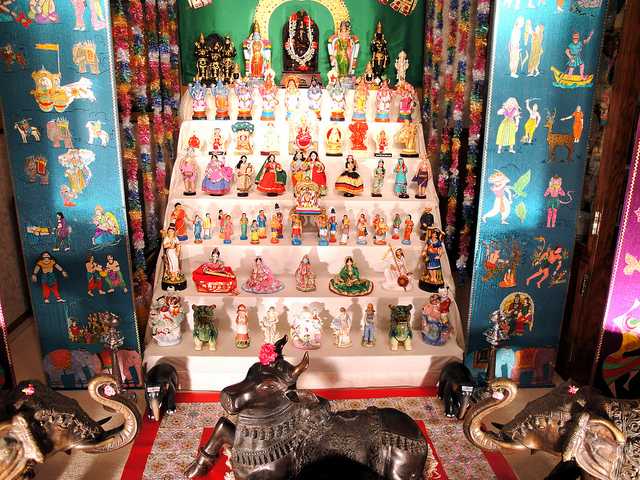
In Kerala, the last three days—Durgashtami, Mahanavami, and Vijayadashami—are dedicated to Goddess Saraswati. Young children are introduced to reading and writing during the festival.
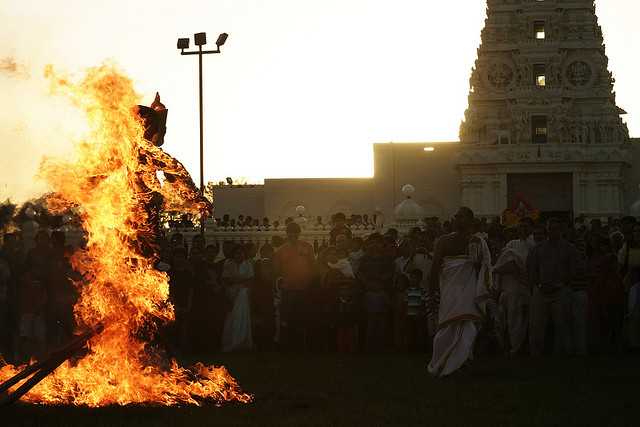
North India: Ramlila and Dussehra
In this part of the country, this festival is known as Navaratras and is observed with a period of fasting for seven days. On the eighth day, the fast is broken by inviting home young girls as an avatar of the Goddess herself known as Kanjak Devis, to be worshipped with traditional ceremonies.Navami is the ninth day of the festival where the seeds of pulses or cereals that were sown on the first day and worshipped all through the days have now sprouted, and after the puja, the seedlings are immersed in water. It is a custom indicated towards the harvesting customs of the place.
In many parts of North India, Ramaleela – a play on the epic Ramayana is performed. Similar to the celebrations in South India, the tenth day of Navaratri known as Dusshera is celebrated here in the same way by burning the effigies of Ravana. However, here the effigies of Ravana’s brother Kumbhakarna and son Meghanand are also burnt along with Ravana.
Read about Dussehra in Kullu
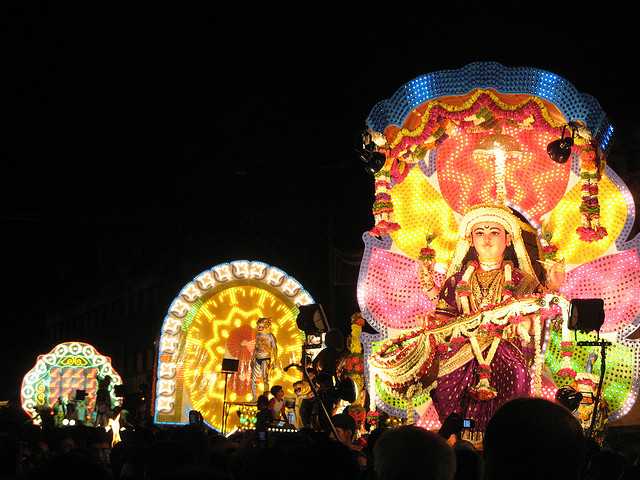
Best Places to Experience Navratri in India 2025
- Vadodara, Gujarat – Known for the largest Garba and Dandiya nights.
- Kolkata, West Bengal – Witness the grandeur of Durga Puja pandals.
- Mumbai, Maharashtra – Home to Bollywood-style dandiya nights and temple rituals.
- Mysore, Karnataka – Famous for Mysore Dasara celebrations.
- Delhi and Varanasi – Experience Ramlila performances and grand Dussehra festivities.
Significance of Navratri
Navratri is celebrated in honor of Goddess Durga, who represents Shakti (divine feminine power). According to Hindu mythology, it marks the victory of Goddess Durga over the demon Mahishasura, signifying the triumph of righteousness. Each of the nine nights is dedicated to one form of the Goddess, known as the Navadurga.Devotees observe fasting, prayers, and rituals during this period to seek divine blessings, prosperity, and spiritual upliftment. The festival also signifies the seasonal transition and is considered an auspicious time for new beginnings.
